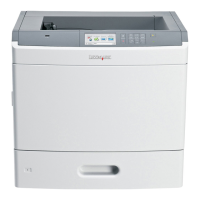2-30 Service Manual
5062
Print quality
Note: These symptoms may require replacement of one or more CRUs (Customer Replaceable Units)
designated as supplies or maintenance items, which are the responsibility of the customer. With the customer's
permission, you may need to install a developer (toner) cartridge.
Service tip: Before troubleshooting any print quality problems, do the following:
1. Print a menu settings page, and then check the life status of all supplies. Any supplies that are low should
be replaced.
Note: Be sure and keep the original menu page to restore the customer's custom settings if needed.
2. On the menu page, make sure the following is set to the default level:
– Color Correction: Set to Auto.
– Print Resolution: Set to 4800 dpi (print quality problems should be checked at different resolution
settings).
– Toner Darkness: Set to 4 (default).
– Color Saver: Set to OFF.
– RGB Brightness, RGB Contrast, RGB Saturation: Set to 0.
– Color Balance: Select Reset Defaults to zero out all colors.
– Check the paper type, texture and weight settings against what is loaded in the printer.
Once the printer has been restored to its default levels, do the following:
3. Inspect the transfer module for damage. Replace if damaged.
4. Inspect the print cartridges for damage. Replace if damaged.
5. If paper other than 20 lb plain letter/A4 paper is being used, load 20 lb plain letter/A4 and print the Print
Quality pages to see if the problem remains. Use Tray 1 to test print quality problems.
6. Print the Print Quality Pages, and then look for variations in the print from what is expected.
An incorrect printer driver for the installed software can cause problems. Incorrect characters could print, and
the copy may not fit the page correctly.
Measure all voltages from the connector to the printer ground.
Symptom table—print quality
Symptom Action
Background (fog) Go to “Background (fog)” on page 2-31.
Blank page Go to “Blank page” on page 2-33.
Blurred or fuzzy print Go to “Blurred or fuzzy print” on page 2-34.
Characters have jagged or uneven edges Go to “Characters have jagged or uneven edges” on
page 2-34
Clipped images Go to “Clipped images” on page 2-34
Colors not properly aligned Go to “Colors not properly aligned” on page 2-35
Horizontal banding Go to “Horizontal banding” on page 2-36.
Horizontal lines Go to “Horizontal lines” on page 2-36.
Light colored line, white line, or incorrectly
colored line
Go to “Light colored line, white line, or incorrectly colored
line” on page 2-37.
Media damage Go to “Media damage” on page 2-38
Mottle (2–5mm speckles) Go to “Mottle (2–5mm speckles)” on page 2-39.
Paper curl Go to “Paper curl” on page 2-39
Print irregularities Go to “Print irregularities” on page 2-40.
Print is too dark Go to “Print is too dark” on page 2-41

